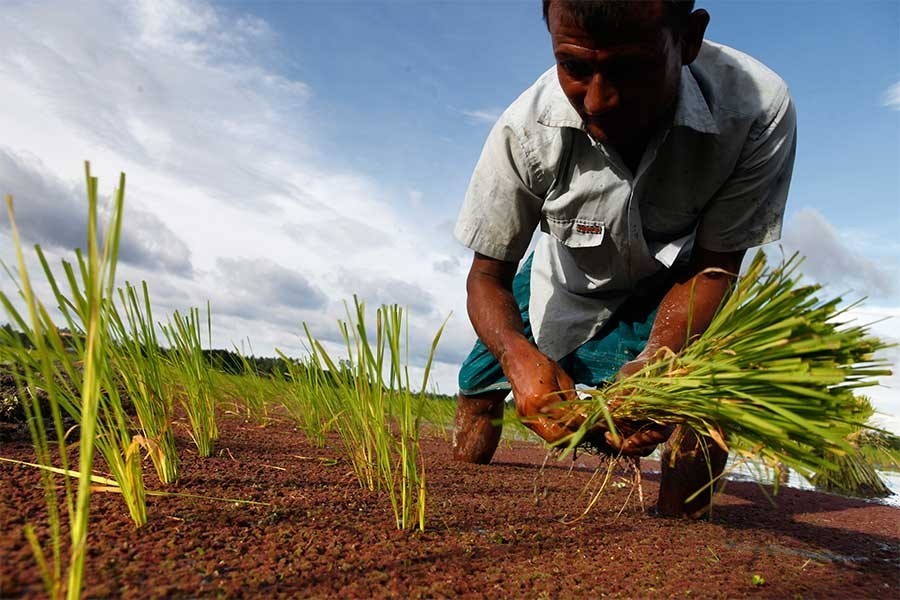
Published :
Updated :

Private bank financing for the agricultural sector remained less than 2.0 per cent out of their total loans during the period between 2007 and 2017, according to a latest research.
Besides, short-term loan disbursement was higher than that of long-term loan during the period.
On the other hand, the financing percentage was 8.0 for public banks, it showed.
The findings were revealed on Monday at a research workshop titled "Addressing Agriculture through Value Chain Financing- How to attract Banks?"
Bangladesh Institute of Bank Management (BIBM) conducted the research on some 24 banks.
BIBM director general Toufic Ahmad Choudhury presided over the workshop while its executive committee chairman and deputy governor of Bangladesh Bank SM Moniruzzaman was present as the chief guest.
Though a high degree of variation in agricultural loan disbursement by private and foreign commercial banks was observed from 2006 to 2017, the rate remained below 2.0 per cent, Prof Md Mohiuddin Siddique, director of BIBM, said while presenting the research findings.
"The participation of privately-owned banks in agricultural finance is mostly driven by the regulations of the central bank," he said.
Short-term agricultural loan was found capturing the dominant share and it was 93 per cent in fiscal year 2018, he noted.
During the period between 2014 and 2018, 59 per cent of agricultural credit was disbursed to crops, followed by 10 per cent to livestock and poultry, 9.0 per cent to fisheries and 6.0 per cent to poverty alleviation, the study showed.
The credit rate was only 1.0 per cent for irrigation and agri- equipment and zero per cent for grain storage and marketing, it revealed.
Some 64 per cent of surveyed banks have separate credit policy for agriculture while the majority (54 per cent) of them formulated their policy between 2010 and 2014, according to the research.
Lower interest income, default risk, higher supervisory cost, repayment dependency on external factor, lack of crop insurance policy, unstable prices of agricultural products and dealing with financially illiterate people, among others, have been identified as the risk factors.
Showing that non-payment in agricultural loan was low, the study also stressed financing for different segments of the value chain for higher growth.
The share of banks especially private banks in agricultural credit remains relatively at a low level, Mr Moniruzzaman said, adding that the concept of value chain financing may be one very plausible solution to making agriculture a vibrant tool for the bankers.
However, banks' involvement in agri-finance is still mainly driven by the regulations, he said. "We don't see the active presence of value chain financing as a tool of addressing agricultural financing."
Banks are needed to apprehend the feasibility of value chain financing right now and prepare and develop their capacity to engage in value chain financing, he said, stressing diversification of areas of business and inclusion of a new class of borrowers by the banks.
Helal Ahmed Chowdhury, supernumerary professor at BIBM, said loan should be given for all segments of the value chain as from production level to export activities that included import and marketing are linked with the agricultural sector.
Md Yasin Ali, also supernumerary professor at BIBM, said 10 per cent of the large borrowers become defaulters while banks have reservations about providing 2.0 per cent agricultural loan.
He called on the banks not to make profit from financing for the agricultural sector, saying that they produce food for all.
Alauddin A Majid, chairman of board of directors of BASIC Bank, recommended financing all subsectors related to agriculture.
He also suggested identifying new products like agri-insurance and bond.
Md Ali Hossain Prodhania, managing director of Bangladesh Krishi Bank, said only 30 per cent of the agricultural demands have been met by the banking sectors while the majority of the demands are yet to be fulfilled.
Loan has been disbursed at a rate of 9.0 per cent while its management cost is more than 10 per cent, he said, adding that the government is subsidising the capital shortfall.
Munni_fe@yahoo.com


 For all latest news, follow The Financial Express Google News channel.
For all latest news, follow The Financial Express Google News channel.